Experimental Study on the Heat Exchange Mechanism in a Simulated Self-Circulation Wellbore
Abstract
:1. Introduction
2. Experimental Section
2.1. Equipment
2.2. Materials
2.3. Procedures
- Use the advection pump to inject the low-temperature water from the intermediate container into the fluid circulation system at a rate of 10 mL/min, drive all the air out of the circulation system, then close the outlet of the loop, and continue injecting the water into the loop to increase the pressure to 10 MPa, then close the inlet of the loop.
- Turn on the thermotank to heat and maintain the heat exchange tube with granite jacket or sand cylinder at 150 °C, and set the cooling temperature of the low-temperature water bath to 20 °C.
- When the pressure and temperature in the heat exchange tube reaches steady state (the additional pressure may need to be released due to the temperature increase), start the plunger metering pump to circulate the water in the heat exchange tube at a rate of 106.7 mL/min. The cold water flows into the casing annulus and hot water comes out from the inner tubing.
- Open the computer and record the temperature and pressure changes in the heat exchange system every 10 s. When the outlet temperature reaches steady state 2 h later, the experiment is over.
2.4. Schemes
3. Experimental Results and Analysis
3.1. The Basic Law of Heat Exchange in the Self-Circulation Wellbore
3.2. The Influence of Various Factors on Wellbore Heat Exchange
3.2.1. Reservoir Type
3.2.2. Reservoir Temperature
3.2.3. Inlet Pressure of Water
3.2.4. Injection Rate of Water
3.2.5. Thermal Conductivity of the Inner Tubing
3.3. Estimation of Heat Mining Rate on the Field-Scale by Similarity Analysis
4. Conclusions
Author Contributions
Funding
Acknowledgments
Conflicts of Interest
References
- Lu, S.M. A global review of enhanced geothermal system (EGS). Renew. Sustain. Energy. Rev. 2018, 82, 2902–2921. [Google Scholar] [CrossRef]
- Tester, J.W.; Anderson, B.J.; Batchelor, A.S.; Blackwell, D.D.; DiPippo, R.; Drake, E.M.; Garnish, J.; Livesay, B.; Moore, M.C.; Nichols, K.; et al. The future of geothermal energy: Impact of enhanced geothermal systems (EGS) on the United States in the 21st century. In Proceedings of the Thirty-Second Workshop on Geothermal Reservoir Engineering, Stanford, CA, USA, 2–4 January 2006. [Google Scholar]
- Haraden, J. The status of hot dry rock as an energy source. Energy 1992, 17, 777–786. [Google Scholar] [CrossRef]
- Wang, G.L.; Zhang, W.; Ma, F.; Lin, W.J.; Liang, J.Y.; Zhu, X. Overview on hydrothermal and hot dry rock researches in China. China Geol. 2018, 1, 273–285. [Google Scholar] [CrossRef]
- Zhang, L.; Ezekiel, J.; Li, D.; Pei, J.; Ren, S. Potential Assessment of CO2 Injection for Heat Mining and Geological Storage in Geothermal Reservoirs of China. Appl. Energy 2014, 122, 237–246. [Google Scholar] [CrossRef]
- Kumari, W.G.P.; Ranjith, P.G.; Perera, M.S.A.; Li, X.; Li, L.H.; Chen, B.K.; Isaka, B.A.; De Silva, V.R.S. Hydraulic fracturing under high temperature and pressure conditions with micro CT applications: Geothermal energy from hot dry rocks. Fuel 2018, 230, 138–154. [Google Scholar] [CrossRef]
- Lu, C.; Wang, G.L. Current status and the prospect of hot dry rock research. Sci. Technol. Rev. 2015, 33, 13–21. [Google Scholar]
- Liao, Z.; Wan, T.; Zhang, Z. The enhanced geothermal system (EGS): Huge capacity and difficult exploitation. Earth Sci. Front. 2015, 22, 335–344. [Google Scholar]
- Kujawa, T.; Nowak, W.; Stachel, A.A. Utilization of existing deep geological wells for acquisitions of geothermal energy. Energy 2006, 31, 650–664. [Google Scholar] [CrossRef]
- Bu, X.; Ma, W.; Li, H. Geothermal energy production utilizing abandoned oil and gas wells. Renew. Energy 2011, 41, 80–85. [Google Scholar] [CrossRef]
- Cui, G.; Ren, S.; Zhang, L.; Ezekiel, J.; Enechukwu, C.; Wang, Y.; Zhang, R. Geothermal exploitation from hot dry rocks via recycling heat transmission fluid in a horizontal well. Energy 2017, 128, 366–377. [Google Scholar] [CrossRef]
- Holmberg, H.; Acuña, J.; Næss, E.; Sønju, O.K. Thermal evaluation of coaxial deep borehole heat exchangers. Renew. Energy 2016, 97, 65–76. [Google Scholar] [CrossRef]
- Song, X.; Zheng, R.; Li, G.; Shi, Y.; Wang, G.; Li, J. Heat extraction performance of a downhole coaxial heat exchanger geothermal system by considering fluid flow in the reservoir. Geothermics 2018, 76, 190–200. [Google Scholar] [CrossRef]
- Nian, Y.L.; Cheng, W.L. Evaluation of geothermal heating from abandoned oil wells. Energy 2018, 142, 592–607. [Google Scholar] [CrossRef]
- Cheng, W.L.; Liu, J.; Nian, Y.L.; Wang, C.L. Enhancing geothermal power generation from abandoned oil wells with thermal reservoirs. Energy 2016, 109, 537–545. [Google Scholar] [CrossRef]
- Wang, Y.; Zhang, L.; Cui, G.; Kang, J.; Ren, S. Geothermal development and power generation by circulating water and isobutane via a closed-loop horizontal well from hot dry rocks. Renew. Energy 2019, 136, 909–922. [Google Scholar] [CrossRef]
- Cheng, W.L.; Li, T.; Nian, Y.L.; Wang, C.L. Studies on geothermal power generation using abandoned oil wells. Energy 2013, 59, 248–254. [Google Scholar] [CrossRef]
- Beier, R.A.; Acuña, J.; Mogensen, P.; Palm, B. Borehole resistance and vertical temperature profiles in coaxial borehole heat exchangers. Appl. Energy 2013, 102, 665–675. [Google Scholar] [CrossRef]
- Beier, R.A.; Acuña, J.; Mogensen, P.; Palm, B. Transient heat transfer in a coaxial borehole heat exchanger. Geothermics 2014, 51, 470–482. [Google Scholar] [CrossRef]
- Gordon, D.; Bolisetti, T.; Ting, D.S.; Reitsma, S. Experimental and analytical investigation on pipe sizes for a coaxial borehole heat exchanger. Renew. Energy 2018, 115, 946–953. [Google Scholar] [CrossRef]
- McDaniel, A.; Tinjum, J.; Hart, D.J.; Lin, Y.F.; Stumpf, A.; Thomas, L. Distributed thermal response test to analyze thermal properties in heterogeneous lithology. Geothermics 2018, 76, 116–124. [Google Scholar] [CrossRef]
- Dai, C.; Li, J.; Shi, Y.; Zeng, L.; Lei, H. An experiment on heat extraction from a deep geothermal well using a downhole coaxial open loop design. Appl. Energy 2019, 252, 11347. [Google Scholar] [CrossRef]
- Zhang, F.Z.; Jiang, P.X.; Xu, R.N. System thermodynamic performance comparison of CO2-EGS and water-EGS systems. Appl. Therm. Eng. 2013, 61, 236–244. [Google Scholar] [CrossRef]
- Cui, G.; Zhang, L.; Ren, S. Assessment of heat mining rate for geothermal exploitation from depleted high-temperature gas reservoirs via recycling supercritical CO2. Energy Procedia 2017, 105, 875–880. [Google Scholar] [CrossRef]
- Zhang, J.Z.; Chang, H.P. Heat Transfer; Science Press: Beijing, China, 2015. [Google Scholar]
- Zanchini, E.; Lazzari, S.; Priarone, A. Effects of flow direction and thermal short-circuiting on the performance of small coaxial ground heat exchangers. Renew. Energy 2010, 35, 1255–1265. [Google Scholar] [CrossRef]
- Peng, Y.L.; Li, W.X.; Wei, K.J.; Xie, H.; Wang, Y. Principle and verification of a similar experiment system for vertical ground heat exchangers. Heat. Vent. Air Cond. 2018, 48, 45–49. [Google Scholar]
- Wang, Y. Geothermal Exploitation via Circulating Fluid within a Closed-Loop Horizontal Well from Hot Dry Rocks. Master’s Thesis, China University of Petroleum (East China), Qingdao, China, 2019; pp. 29–31. [Google Scholar]
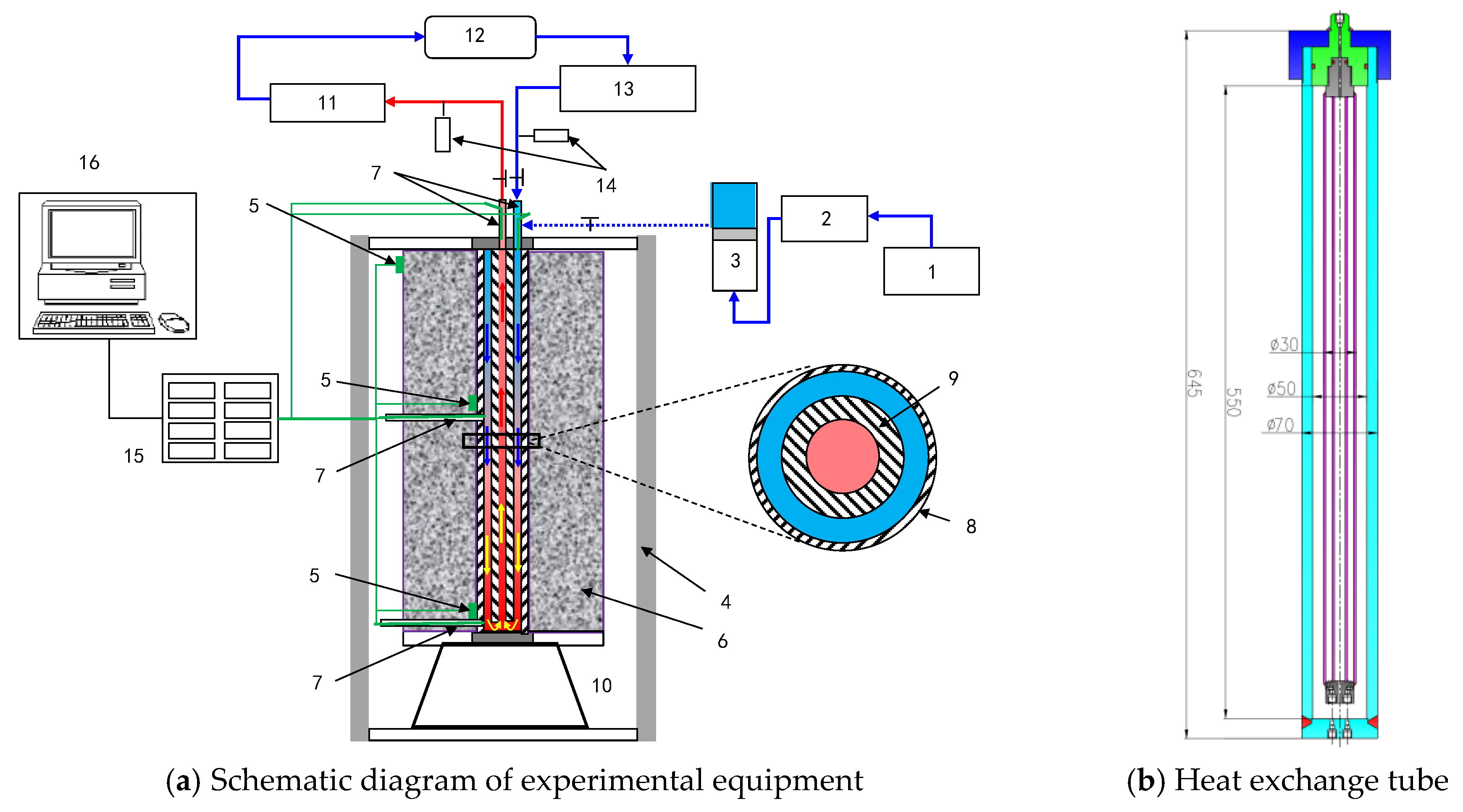

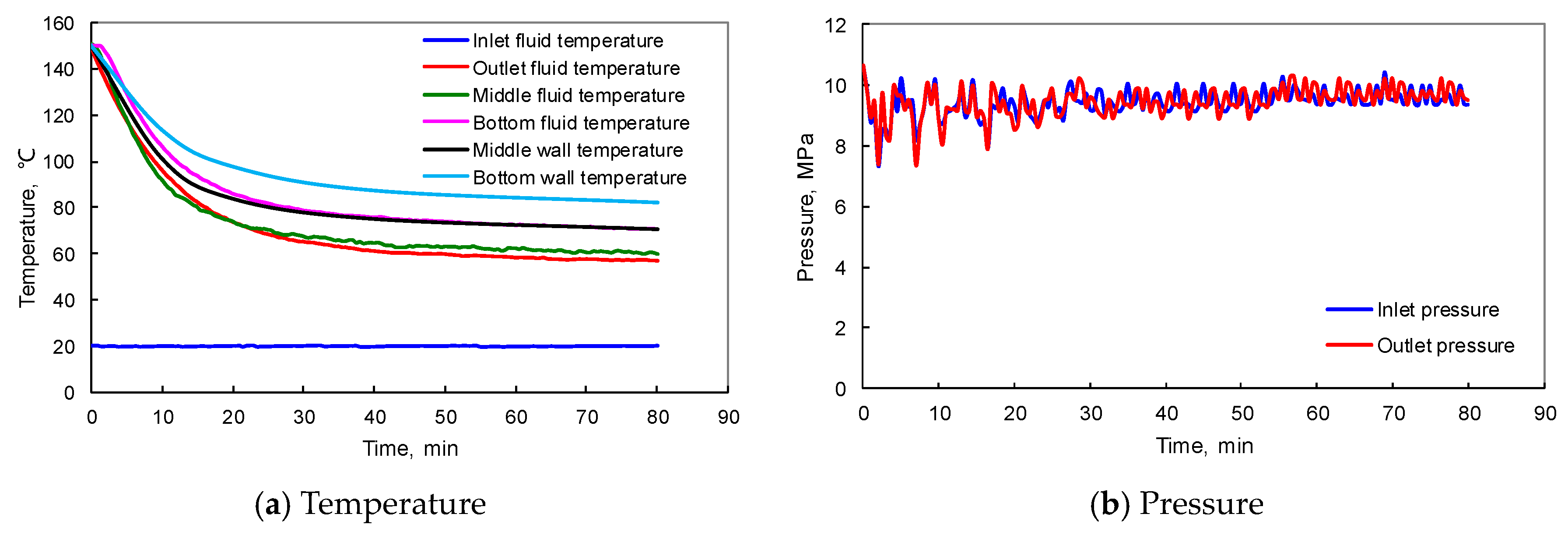

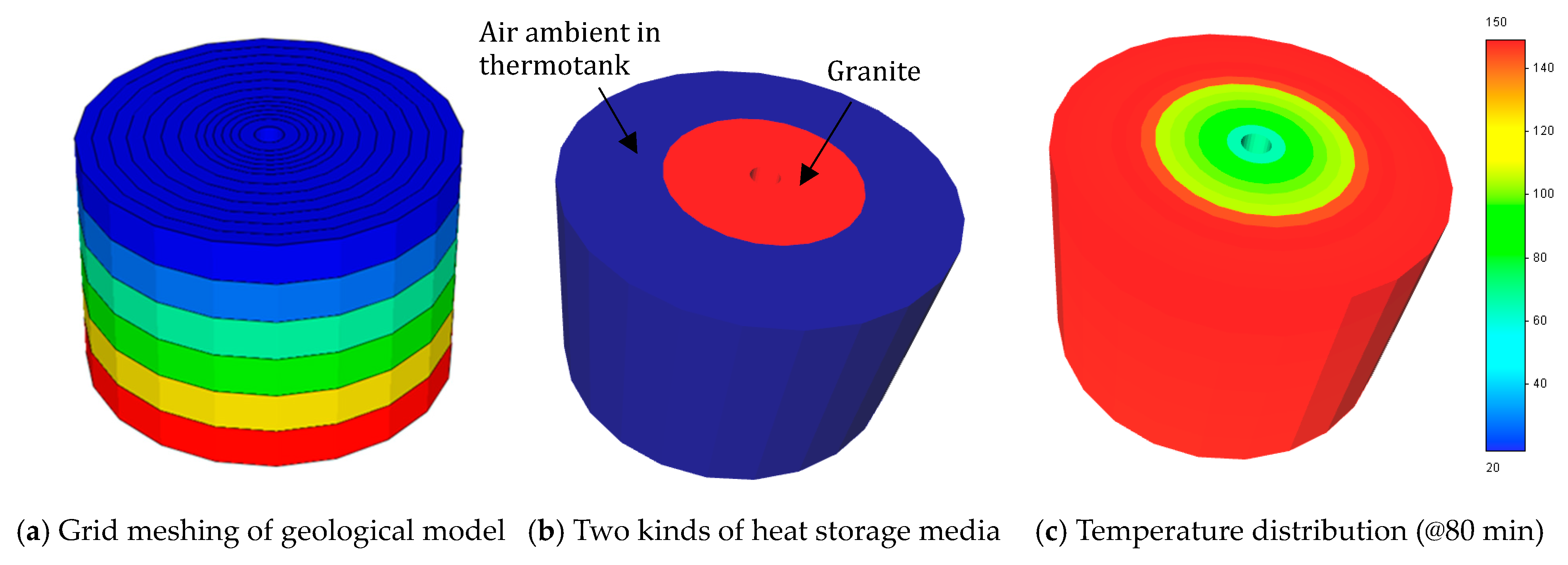
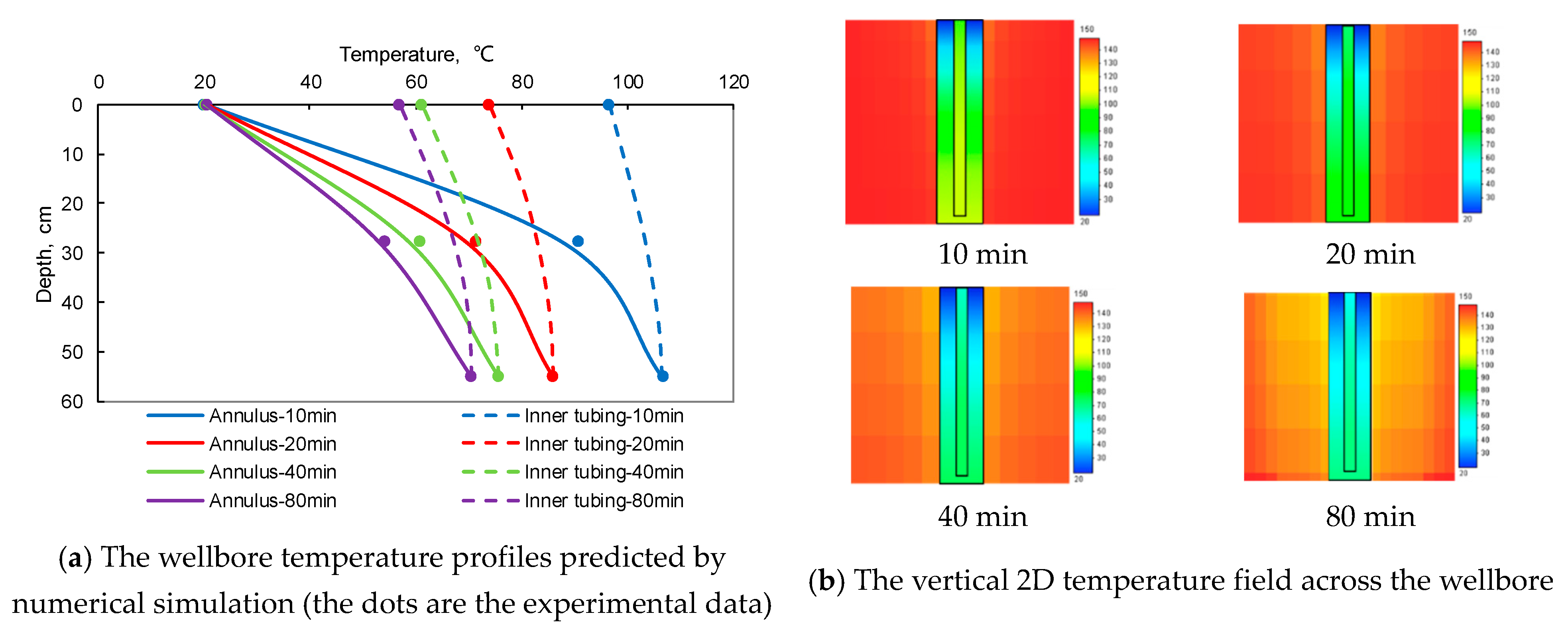

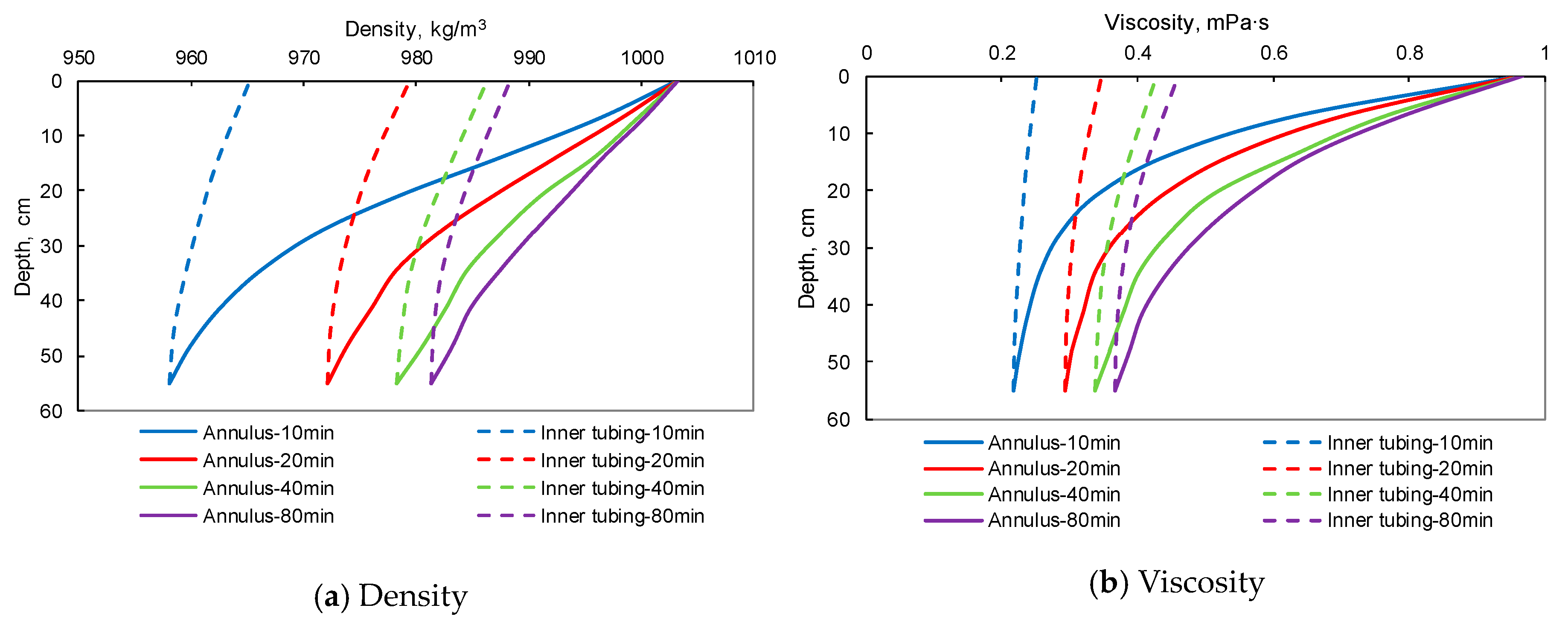
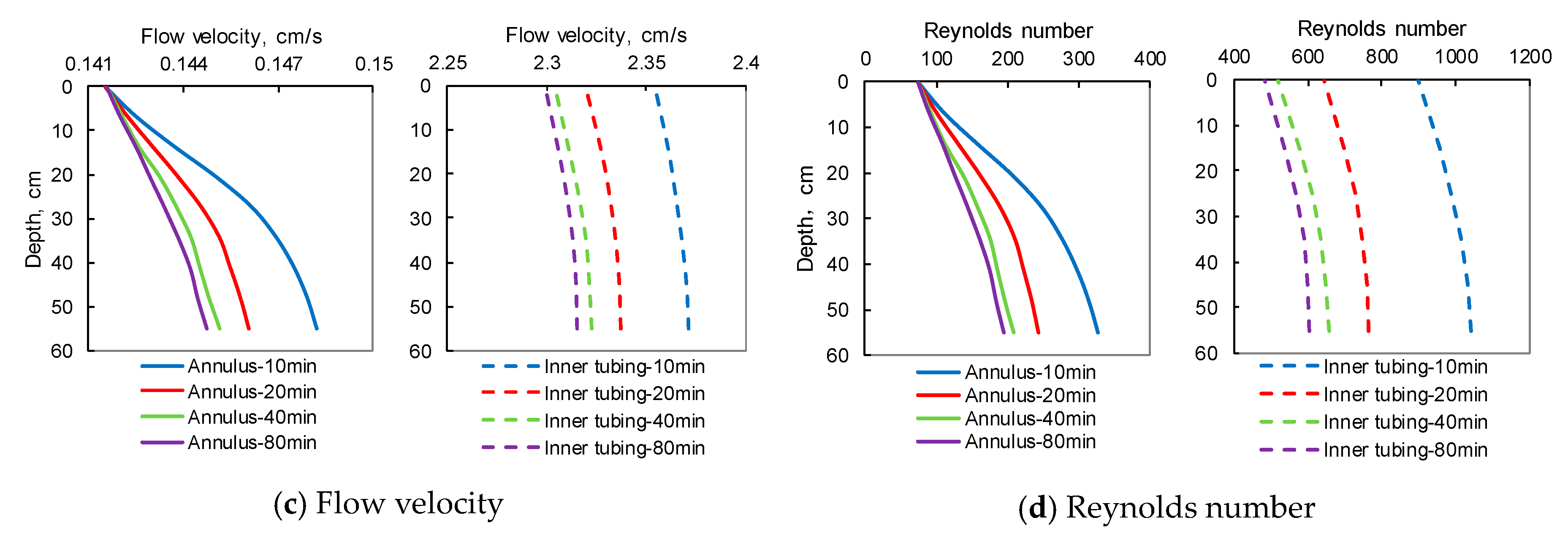
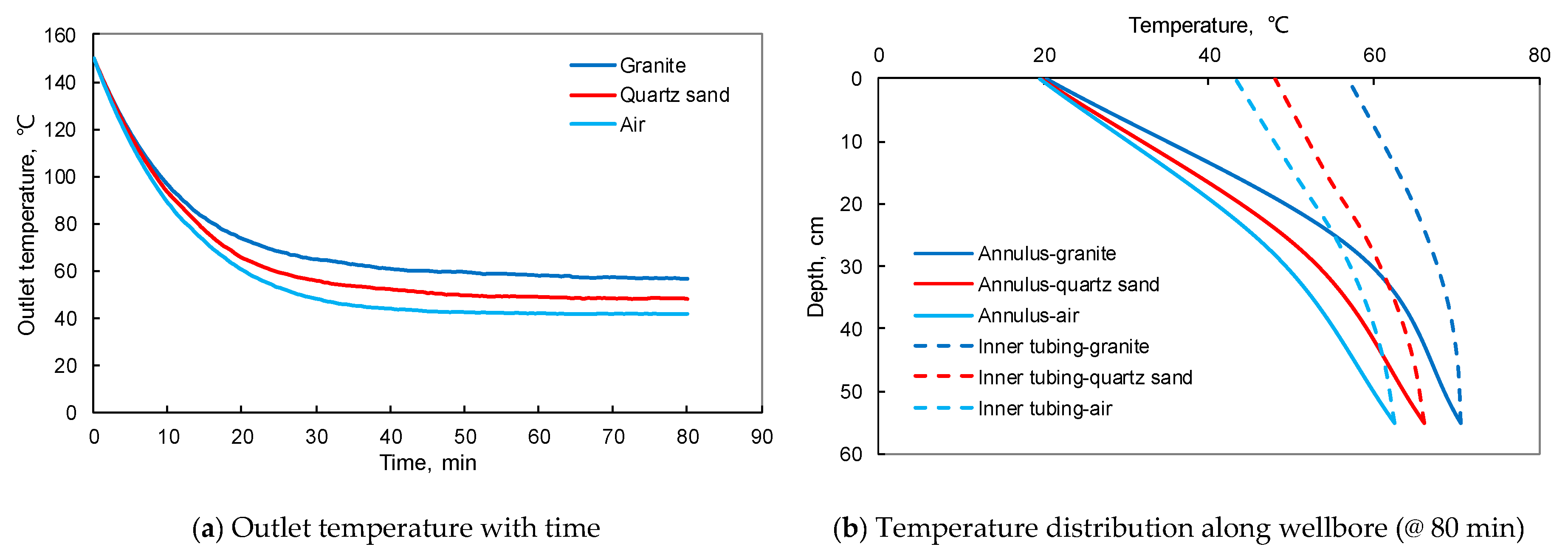
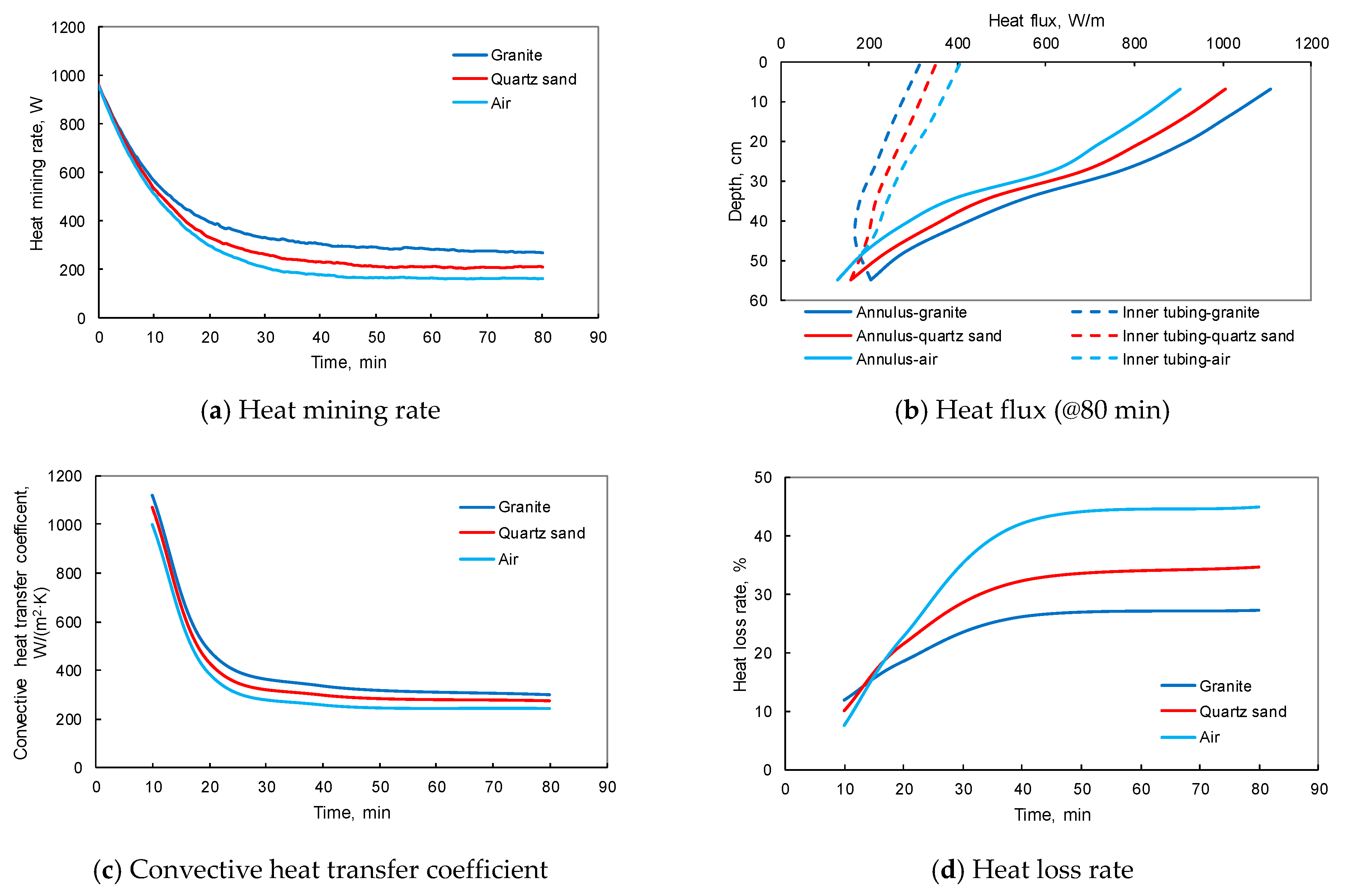


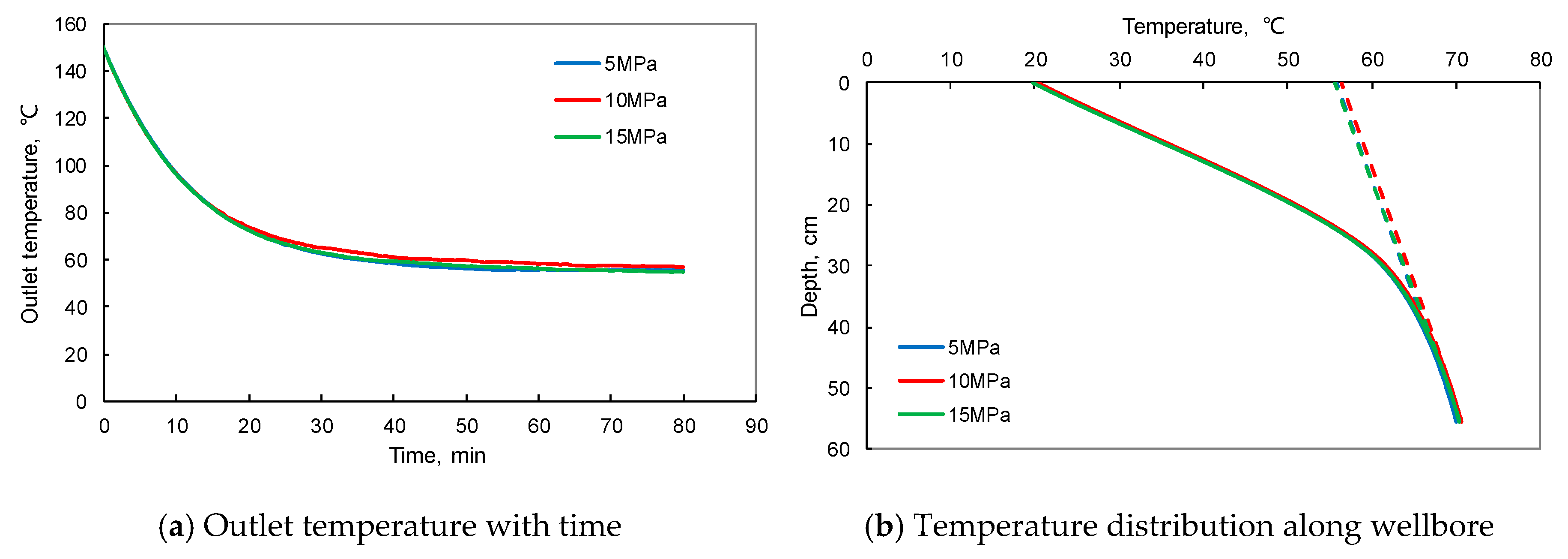
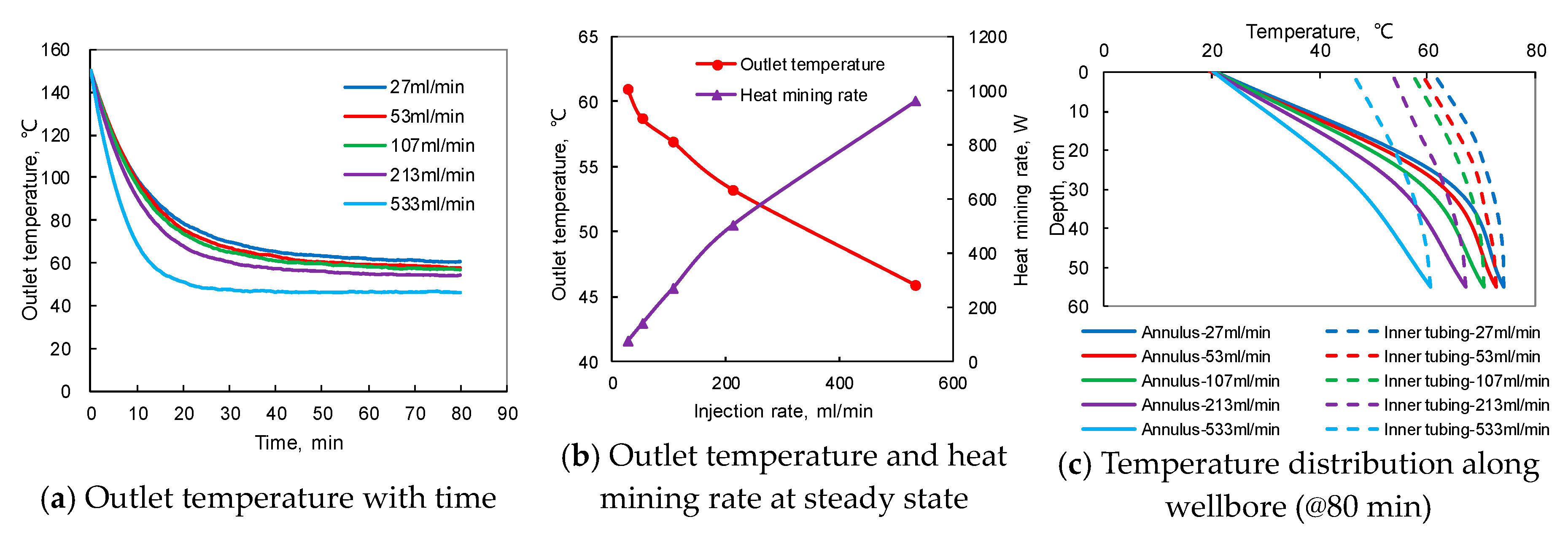
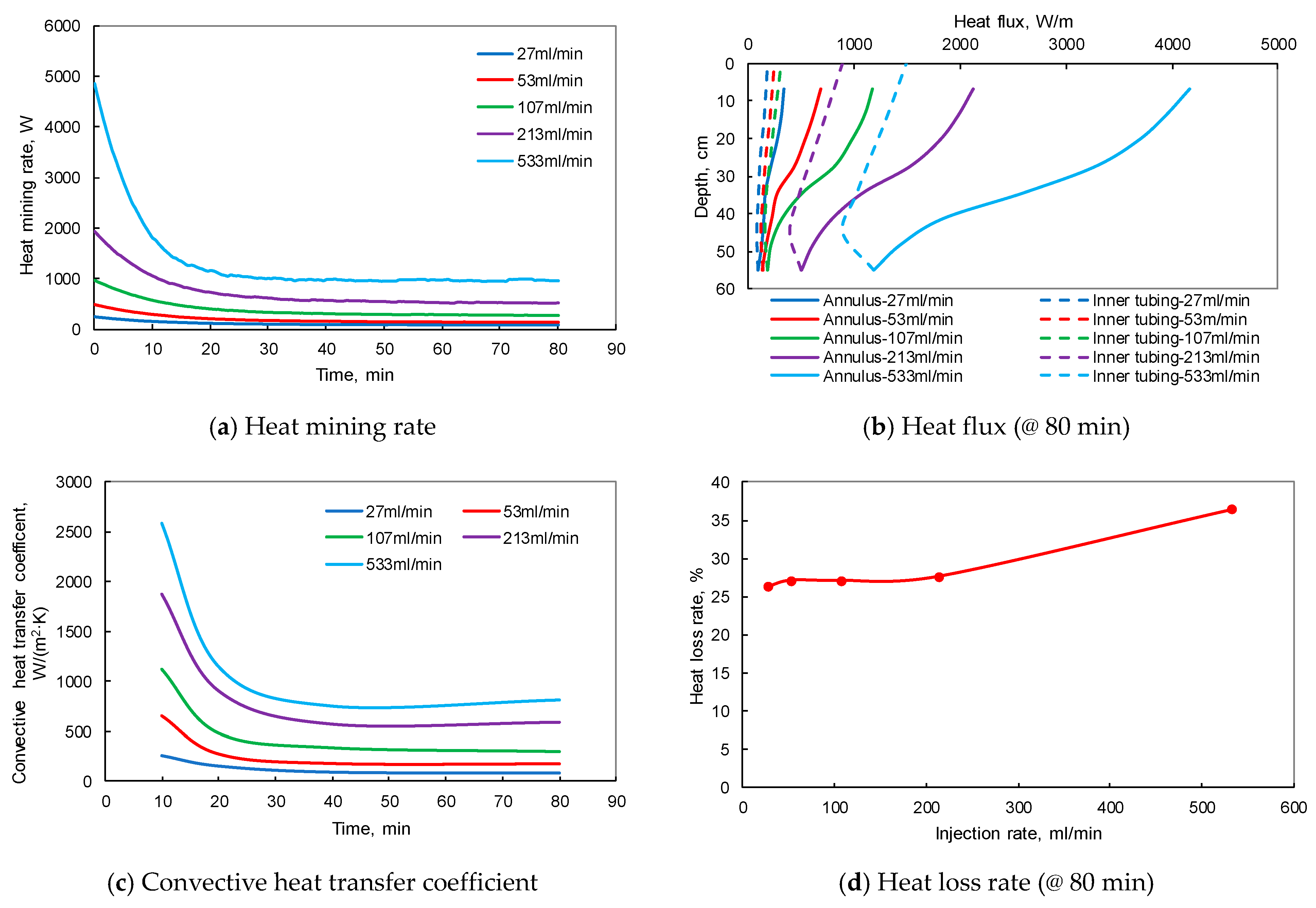
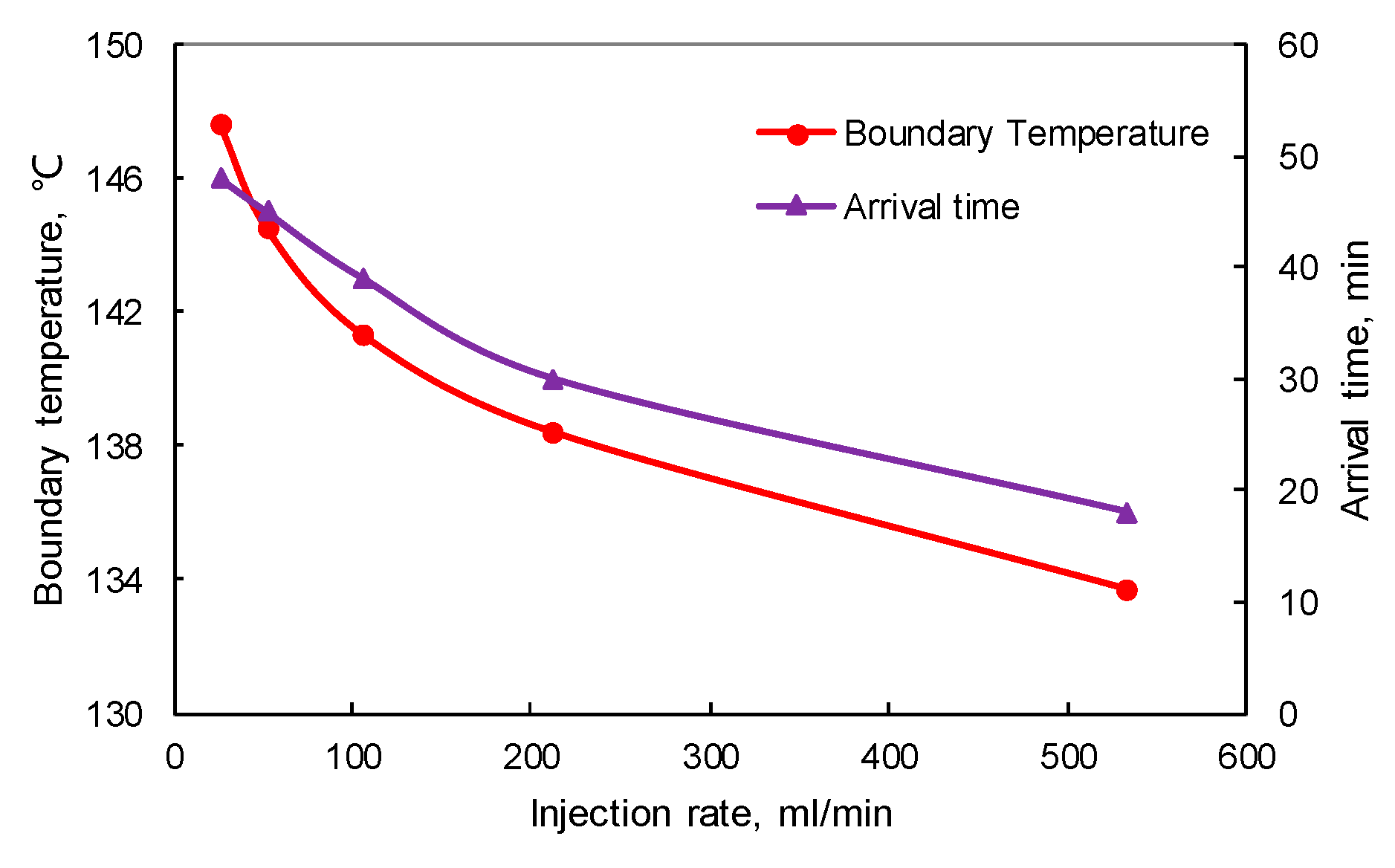
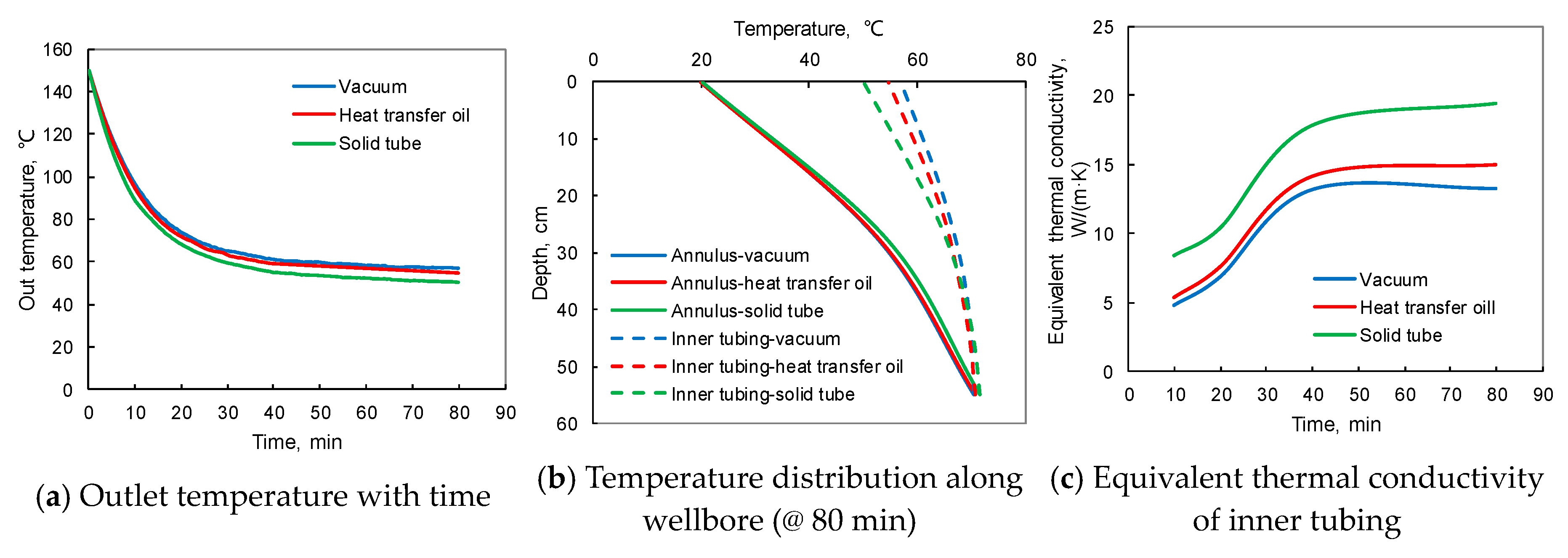
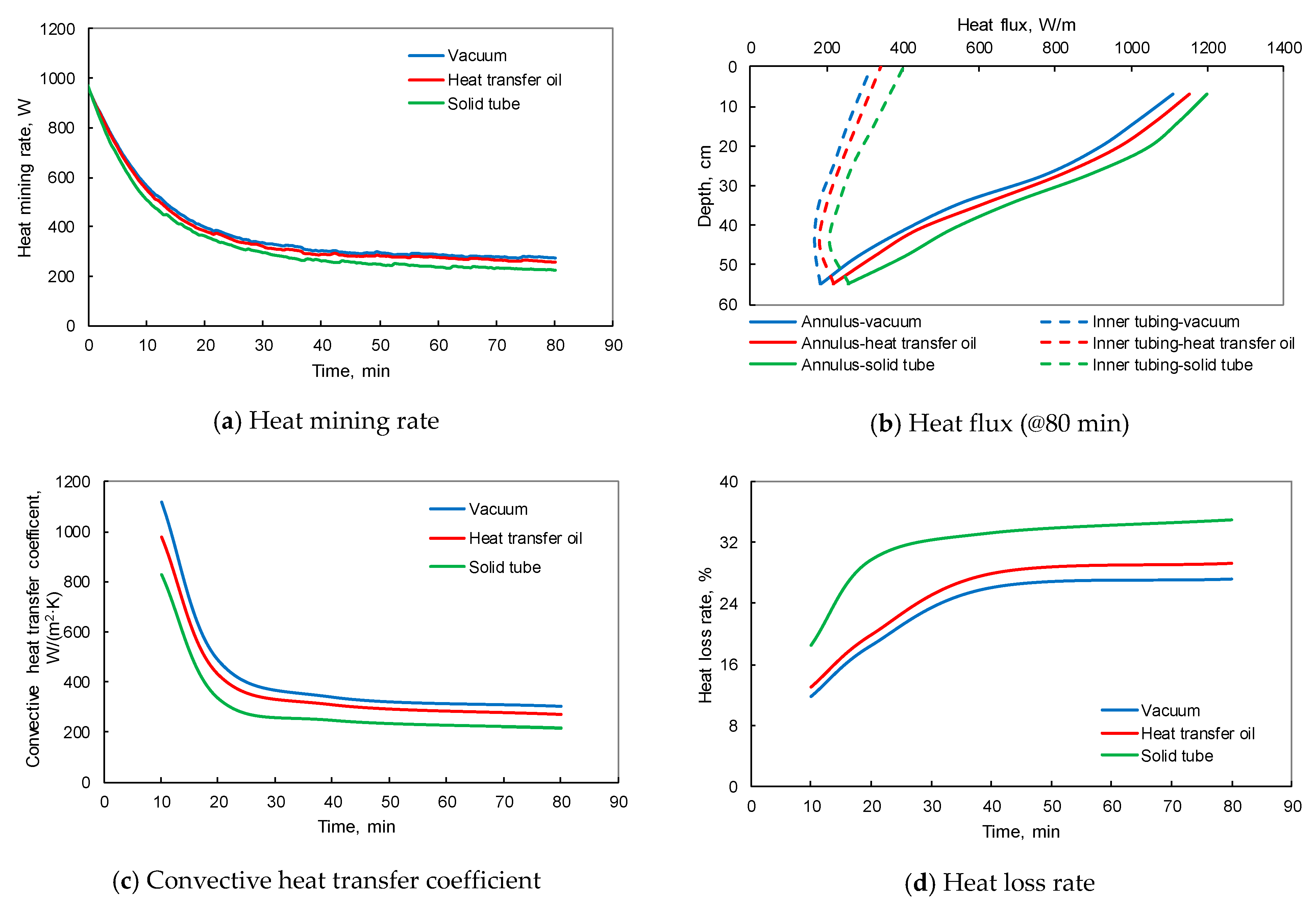
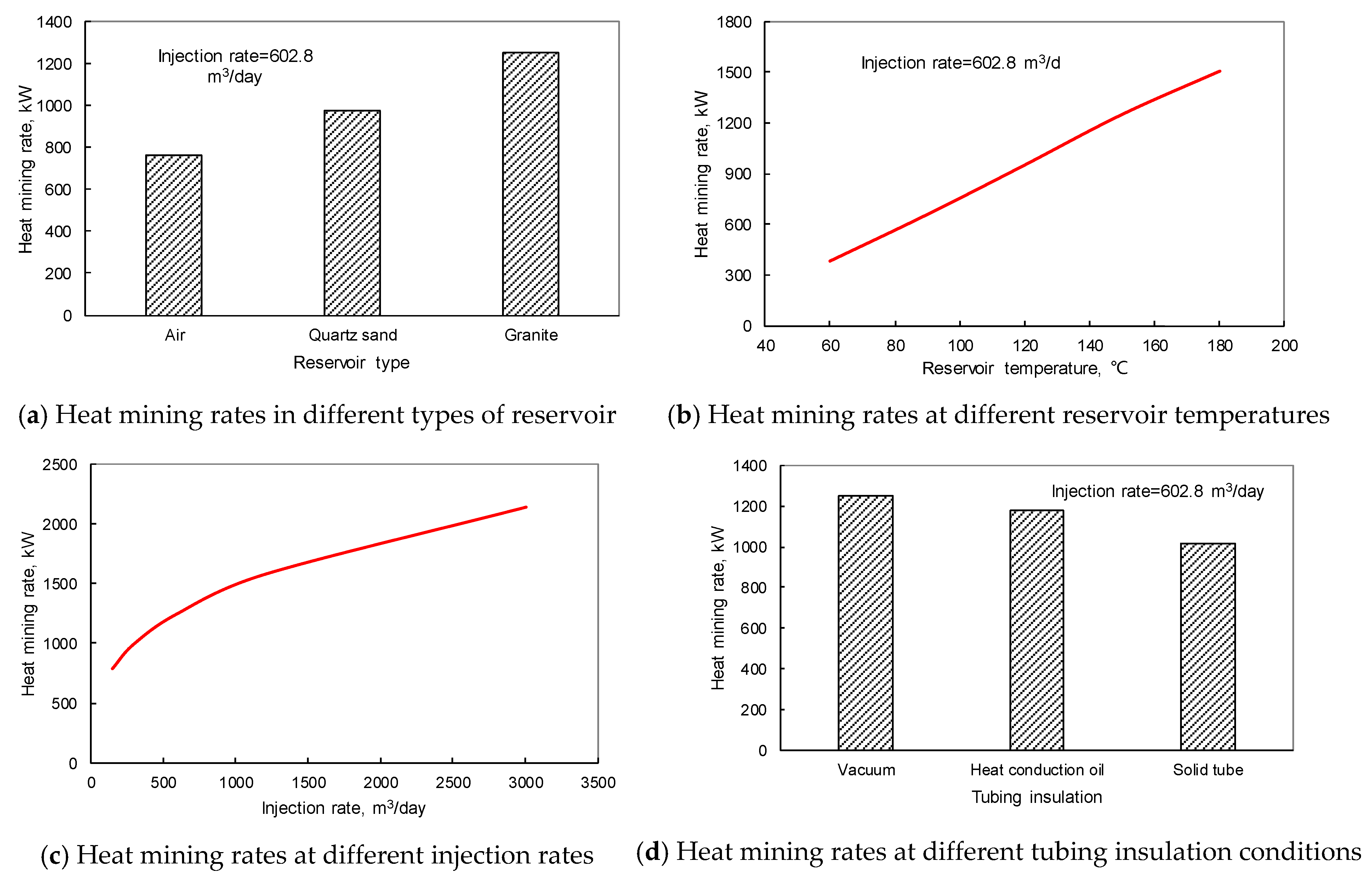
| Property | Water as Heat Transfer Fluid | Air in the Thermotank | Heat Transfer Oil Filled in the Tubing Wall | Quartz Sand Filled in the Cylinder | Granite Jacket | Cylinder Used for Filling Sand | Heat Exchange Tube |
|---|---|---|---|---|---|---|---|
| Density, kg/m3 | 998.2 | 1.1691 | 1007 | 1332.1 | 2700 | 7930 | 7930 |
| Specific heat capacity, J/(kg·K) | 4182 | 1012 | 1621.8 | 872 | 653.2 | 500 | 500 |
| Thermal conductivity, W/(m·K) | 0.62 | 0.024 | 0.13 | 0.272 | 2.7–3.2 | 16.2 | 16.2 |
| Volume, m3 | 800 × 10−6 | 0.2489 | 183 × 10−6 | 0.01673 | 0.0205 | 0.00086 | 0.00128 |
| 100 °C heat reserve, kJ | 266.6 | 23.6 | 23.9 | 1554.7 | 2892.4 | 272.8 | 406 |
| 150 °C heat reserve, kJ | 434.1 | 38.3 | 38.8 | 2526.3 | 4700.1 | 443.3 | 659.8 |
| 200 °C heat reserve, kJ | 601.1 | 53.1 | 50.8 | 3498 | 6507.8 | 613.8 | 913.5 |
| Factors | Values |
|---|---|
| Reservoir type | Air, quartz sand, granite * |
| Reservoir temperature, °C | 60, 90, 120, 150 *, 180 |
| Pressure, MPa | 5, 10 *, 15 |
| Injection rate, mL/min | 27, 53, 107 *, 213, 533 |
| Tubing insulation | Vacuum *, heat-transfer oil, solid tube |
| Parameters | Values | Parameters | Values |
|---|---|---|---|
| Depth, cm | 60 | Thermal conductivity of granite, J/(cm·min·°C) | 5 |
| Reservoir temperature, °C | 150 | Heat capacity of granite, J/(cm3·°C) | 1.76 |
| Inlet temperature, °C | 20 | Thermal conductivity of air, J/(cm·min·°C) | 0.04 |
| Inlet pressure, MPa | 10 | Heat capacity of air, J/(cm3·°C) | 1.2 × 10−3 |
| Injection rate, mL/min | 107 | Thermal conductivity of tubing, J/(cm·min·°C) | 0.4 |
| Inner diameter of tubing, cm | 1 | Thermal conductivity of casing, J/(cm·min·°C) | 0.03 |
| Outer diameter of tubing, cm | 3 | Heat capacity of tubing, J/(cm3·°C) | 3.63 |
| Inner diameter of casing, cm | 5 | Heat capacity of casing, J/(cm3·°C) | 3.63 |
| Outer diameter of casing, cm | 7 | Running time, min | 80 |
| Classification | Wellbore Parameters | Values |
|---|---|---|
| Laboratory scale | Length of heat transfer section , m | 0.55 |
| The inner diameter of the casing , m | 0.05 | |
| The outer diameter of the tubing , m | 0.03 | |
| Field-scale | Length of heat transfer section , m | 2000 |
| The inner diameter of the casing , m | 0.158 | |
| The outer diameter of the tubing , m | 0.114 |
| No | Reservoir | T °C | P MPa | Tubing Wall | Vw1 mL/min | ρw1 kg/m3 | λw1 W/(m·K) | cw1 J/(kg·K) | ΔTm1 °C | Qw1 W | Vw2 m3/d | ρw2 kg/m3 | λw2 W/(m·K) | cw2 J/(kg·K) | ΔTm2 °C | Qw2 kW |
|---|---|---|---|---|---|---|---|---|---|---|---|---|---|---|---|---|
| 1 | granite | 150 | 10 | vacuum | 107 | 988 | 0.65 | 4156 | 10 | 272 | 602.8 | 988 | 0.65 | 4156 | 20 | 1252 |
| 2 | sand | 150 | 10 | vacuum | 107 | 992 | 0.64 | 4154 | 7.73 | 211 | 602.8 | 992 | 0.64 | 4154 | 15.5 | 974 |
| 3 | air | 150 | 10 | vacuum | 107 | 994 | 0.63 | 4154 | 6 | 165 | 602.8 | 994 | 0.63 | 4154 | 12 | 762 |
| 4 | granite | 60 | 10 | vacuum | 107 | 999 | 0.62 | 4157 | 3 | 84 | 602.8 | 999 | 0.62 | 4157 | 6 | 381 |
| 5 | granite | 90 | 10 | vacuum | 107 | 996 | 0.63 | 4155 | 5.3 | 145 | 602.8 | 996 | 0.63 | 4155 | 10.5 | 658 |
| 6 | granite | 120 | 10 | vacuum | 107 | 992 | 0.64 | 4154 | 7.6 | 209 | 602.8 | 992 | 0.64 | 4154 | 15.2 | 952 |
| 7 | granite | 180 | 10 | vacuum | 107 | 984 | 0.66 | 4159 | 12 | 332 | 602.8 | 984 | 0.66 | 4159 | 24 | 1509 |
| 8 | granite | 150 | 10 | vacuum | 27 | 986 | 0.66 | 4157 | 10 | 75 | 152.1 | 986 | 0.66 | 4157 | 20 | 789 |
| 9 | granite | 150 | 10 | vacuum | 53 | 987 | 0.65 | 4156 | 10 | 141 | 298.6 | 987 | 0.65 | 4156 | 20 | 994 |
| 10 | granite | 150 | 10 | vacuum | 213 | 990 | 0.65 | 4155 | 10 | 506 | 1200 | 990 | 0.65 | 4155 | 20 | 1578 |
| 11 | granite | 150 | 10 | vacuum | 533 | 990 | 0.64 | 4154 | 10 | 960 | 3002 | 990 | 0.64 | 4154 | 20 | 2141 |
| 12 | granite | 150 | 10 | oil | 107 | 989 | 0.65 | 4155 | 9.4 | 258 | 602.8 | 989 | 0.65 | 4155 | 18.8 | 1181 |
| 13 | granite | 150 | 10 | solid | 107 | 991 | 0.64 | 4154 | 8.1 | 222 | 602.8 | 991 | 0.64 | 4154 | 16.2 | 1017 |
© 2020 by the authors. Licensee MDPI, Basel, Switzerland. This article is an open access article distributed under the terms and conditions of the Creative Commons Attribution (CC BY) license (http://creativecommons.org/licenses/by/4.0/).
Share and Cite
Zhang, L.; Geng, S.; Kang, J.; Chao, J.; Yang, L.; Yan, F. Experimental Study on the Heat Exchange Mechanism in a Simulated Self-Circulation Wellbore. Energies 2020, 13, 2918. https://doi.org/10.3390/en13112918
Zhang L, Geng S, Kang J, Chao J, Yang L, Yan F. Experimental Study on the Heat Exchange Mechanism in a Simulated Self-Circulation Wellbore. Energies. 2020; 13(11):2918. https://doi.org/10.3390/en13112918
Chicago/Turabian StyleZhang, Liang, Songhe Geng, Jun Kang, Jiahao Chao, Linchao Yang, and Fangping Yan. 2020. "Experimental Study on the Heat Exchange Mechanism in a Simulated Self-Circulation Wellbore" Energies 13, no. 11: 2918. https://doi.org/10.3390/en13112918
APA StyleZhang, L., Geng, S., Kang, J., Chao, J., Yang, L., & Yan, F. (2020). Experimental Study on the Heat Exchange Mechanism in a Simulated Self-Circulation Wellbore. Energies, 13(11), 2918. https://doi.org/10.3390/en13112918







